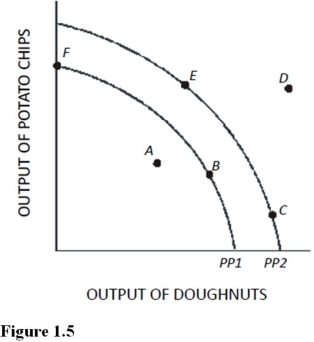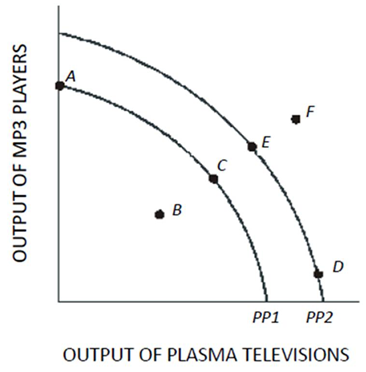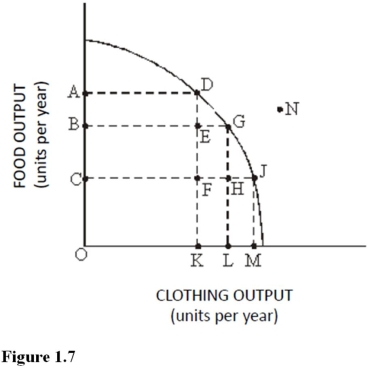A) OA units of food.
B) KL units of clothing.
C) AB units of food.
D) OL units of clothing.
Correct Answer

verified
Correct Answer
verified
True/False
Every time we use scarce resources in one way,we give up the opportunity to use them in other ways.
Correct Answer

verified
Correct Answer
verified
Multiple Choice
One World View article is titled "Chronic Food Shortage Shows Despite Efforts by North Korea to Hide It." If North Korea reduces the size of its military and produces more food,this is most consistent with
A) A movement along the economy's production possibilities curve.
B) Privatization.
C) A laissez faire policy.
D) The law of increasing opportunity costs.
Correct Answer

verified
Correct Answer
verified
Multiple Choice
Use the following figure to answer questions: Figure 1.5 -Using Figure 1.5,if an economy has the capacity to produce represented by PP2,then point E represents
-Using Figure 1.5,if an economy has the capacity to produce represented by PP2,then point E represents
A) A constant trade-off between potato chips and doughnuts.
B) A combination of potato chips and doughnuts that is not attainable.
C) An efficient use of resources.
D) None of the choices are correct.
Correct Answer

verified
Correct Answer
verified
Multiple Choice
Use the following figure to answer questions: Figure 1.4  -Which of the following is true about the combination of plasma televisions and MP3 players represented by point F in Figure 1.4?
-Which of the following is true about the combination of plasma televisions and MP3 players represented by point F in Figure 1.4?
A) Point F is inefficient now.
B) Point F is unattainable even with advances in technology.
C) Point F will be more easily attainable if the government takes control of all privately run factories.
D) Point F can possibly be reached if more economic resources become available or technology improves.
Correct Answer

verified
Correct Answer
verified
True/False
Output combinations that lie inside the production possibilities curve are characterized by efficient use of resources.
Correct Answer

verified
Correct Answer
verified
True/False
All output combinations that lie outside a production possibilities curve are attainable with available resources and technology.
Correct Answer

verified
Correct Answer
verified
Multiple Choice
According to the law of increasing opportunity costs,
A) Greater production leads to greater inefficiency.
B) Greater production means factor prices rise.
C) Greater production of one good requires increasingly larger sacrifices of other goods.
D) Higher opportunity costs induce higher output per unit of input.
Correct Answer

verified
Correct Answer
verified
Multiple Choice
The basic factors of production include
A) Land,labor,money,and capital.
B) Land,labor,money,and inputs.
C) Labor and money.
D) Land,labor,capital,and entrepreneurship.
Correct Answer

verified
Correct Answer
verified
Multiple Choice
Which of the following events would allow the production possibilities curve to shift outward?
A) The economy's capital stock declines.
B) More teenagers enter the labor force.
C) Technology is lost.
D) People begin to retire at earlier ages.
Correct Answer

verified
Correct Answer
verified
Multiple Choice
Factors of production are
A) Scarce in every society.
B) Scarce only in advanced countries.
C) Scarce only in the poorest countries of the world.
D) Unlimited in quantity.
Correct Answer

verified
Correct Answer
verified
Multiple Choice
If North Korea is currently producing at efficiency,and it proceeds to increase the size of its military,then,as long as nothing else changes,its
A) Production possibilities curve will shift outward.
B) Production possibilities curve will shift inward.
C) Production of nonmilitary goods will increase.
D) Production of nonmilitary goods will decrease.
Correct Answer

verified
Correct Answer
verified
Multiple Choice
A mixed economy
A) Is justified by the superiority of laissez faire over government intervention.
B) Utilizes both market and nonmarket signals to allocate goods and services.
C) Relies on the use of central planning by private firms rather than the government.
D) Is one that allows trade with other countries.
Correct Answer

verified
Correct Answer
verified
Multiple Choice
Which of the following is true when an economy is producing efficiently?
A) The economy is producing on the production possibilities curve.
B) The economy is producing outside the production possibilities curve.
C) The economy is getting the fewest goods and services from the available resources.
D) Everyone in the economy is happy.
Correct Answer

verified
Correct Answer
verified
Multiple Choice
Table 1.1 shows the hypothetical trade-off between different combinations of Stealth bombers and B-1 bombers that might be produced in a year with the limited U.S.capacity,ceteris paribus.Complete the table by calculating the required opportunity costs for both the B-1 and Stealth bombers.  - On the basis of your calculations in Table 1.1,you may infer that the law of increasing opportunity costs applies to
- On the basis of your calculations in Table 1.1,you may infer that the law of increasing opportunity costs applies to
A) Stealth bombers but not to B-1 bombers.
B) B-1 bombers but not to Stealth bombers.
C) Both B-1 bombers and Stealth bombers.
D) Neither B-1 bombers nor Stealth bombers.
Correct Answer

verified
Correct Answer
verified
Multiple Choice
Given that resources are scarce,
A) A "free lunch" is possible,but only for a limited number of people.
B) Opportunity costs are experienced whenever choices are made.
C) Poor countries must make choices,but rich countries with abundant resources do not have to make choices.
D) Some choices involve opportunity costs while other choices do not.
Correct Answer

verified
Correct Answer
verified
True/False
The essential feature of the market mechanism is the price signal.
Correct Answer

verified
Correct Answer
verified
Multiple Choice
The book Wealth of Nations was written by
A) Adam Smith in 1776.
B) John Maynard Keynes in 1776.
C) Adam Smith in 1936.
D) John Maynard Keynes in 1936.
Correct Answer

verified
Correct Answer
verified
Multiple Choice
Use the following figure to answer the questions: Figure 1.7:
 -The benefit of producing at point G rather than point D is :
-The benefit of producing at point G rather than point D is :
A) OA units of food.
B) KL units of clothing.
C) AB units of food.
D) OL units of clothing.
Correct Answer

verified
Correct Answer
verified
Multiple Choice
Which of the following is an assumption under which the production possibilities curve is drawn?
A) Total unemployment is zero.
B) The supply of resources is fixed.
C) The price level is changing.
D) Technology is changing.
Correct Answer

verified
Correct Answer
verified
Showing 61 - 80 of 125
Related Exams